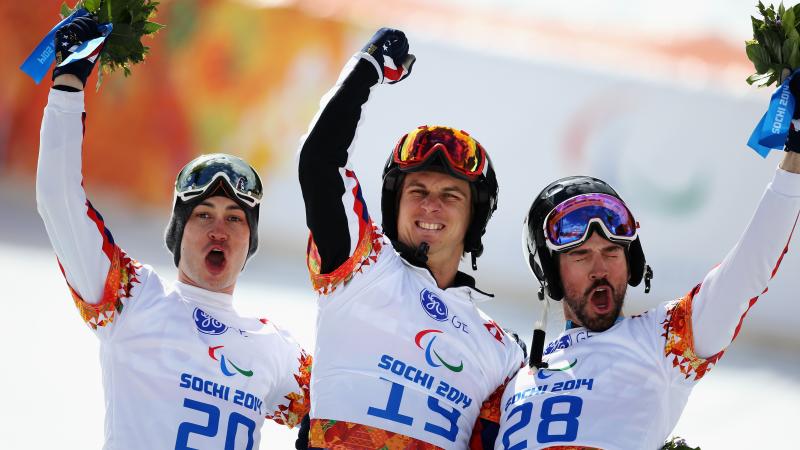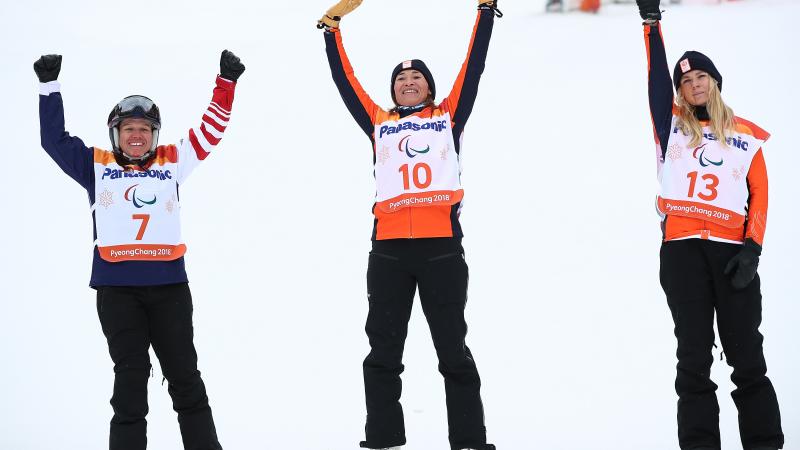HISTORY OF PARA SNOWBOARD
Para Snowboard is practised worldwide and features three disciplines: snowboard-cross, banked slalom and giant slalom.
Athletes combine speed and agility while racing down courses as fast as possible.
Competition includes male and female athletes with a physical impairment such as spinal injury, cerebral palsy and amputation.
Athletes compete in three categories based on their functional ability – SB-LL1 and SB-LL2 for lower-limb impaired riders and SB-UL for upper-limb impaired athletes.
Snowboarders use equipment that is adapted to their needs including snowboard and orthopaedic aids.
Para Snowboard was initially governed by the World Snowboard Federation (WSF), but after a Memorandum of Understanding was signed in 2010, it was taken under World Para Alpine Skiing with a view to continue working with the WSF to develop the sport. World Para Snowboard then acted as the International Federation for the sport until the transfer of governance to the International Ski and Snowboard Federation (FIS) in 2022.
The sport owes its success to the determination of a group of pioneering riders who in 2005 began their quest to have the sport included at the Paralympic Winter Games.
After many years of campaigning, in 2012 it was announced that snowboard would make its debut at the Sochi 2014 Paralympic Winter Games as part of the alpine skiing programme, with two medal events in lower-limb impairment classifications for men and women in snowboard-cross time trial.
A hugely successful debut which attracted worldwide media interest saw Netherlands’ Bibian Mentel-Spee secure the women’s gold whilst US rider Evan Strong took the men’s.
This thrust snowboard onto the global stage and in 2015, the first World Championships were held in La Molina, Spain. Here, banked slalom and snowboard-cross head-to-head were contested for the first time, whilst the lower-limb impaired classifications were split and upper-limb impaired riders also competed for coveted world titles.
The 2015 World Championships saw the culmination of ongoing improvements to the classification system, including the separation of lower-limb impaired riders to SB-LL1 and SB-LL2 which was introduced during the 2014-15 season.
The competition calendar has also been expanded and now takes in some of the best locations around the world for World Cups and Europa Cups, and most recently for the North America and Asia Cups.
This growth was reflected in the number of countries taking part in the Paralympic Winter Games.
GROWTH OF SNOWBOARD AT THE PARALYMPIC WINTER GAMES
| YEAR | COUNTRIES | MEDAL EVENTS | MALE | FEMALE | TOTAL | TOP 3 COUNTRIES |
|---|---|---|---|---|---|---|
| 2014 (as part of alpine skiing) | 20 | 2 | 33 | 12 | 45 | 1. USA 2. NED 3. FRA |
| 2018 | 24 | 10 | 56 | 13 | 69 | 1. USA 2. NED 3= AUS, FIN, JPN |
| 2022 | 21 | 8 | 61 | 14 | 75 | 1. CHN 2. FRA 3. USA |
OVERALL PARALYMPIC MEDALS TABLE
| RANK | COUNTRY | GOLD | SILVER | BRONZE | TOTAL |
|---|---|---|---|---|---|
| 1 | USA | 7 | 8 | 6 | 21 |
| 2 | China | 3 | 3 | 4 | 10 |
| 3 | Netherlands | 3 | 3 | 1 | 7 |
| 4= | Finland | 2 | 2 | 1 | 6 |
| 4= | France | 2 | 2 | 1 | 5 |
TOP 5 MALE PARALYMPIC MEDALLISTS
| RANK | ATHLETE | YEARS COMPETING | GOLD | SILVER | BRONZE | TOTAL |
|---|---|---|---|---|---|---|
| 1 | Matti Suur-Hamari (FIN) | 2018-present | 2 | 1 | 1 | 4 |
| 2 | Mike Schultz (USA) | 2018-present | 1 | 2 | 0 | 3 |
| 3= | Lijia Ji (CHN) | 2022-present | 1 | 1 | 0 | 2 |
| 3= | Evan Strong (USA) | 2014-present | 1 | 1 | 0 | 2 |
| 4= | Simon Patmore (AUS) | 2014-2018 | 1 | 0 | 1 | 2 |
| 4= | Gurimu Narita (JPN) | 2014-2018 | 1 | 0 | 1 | 2 |
| 4= | Noah Elliott (USA) | 2018-present | 1 | 0 | 1 | 2 |
| 4= | Mike Minor (USA) | 2018-present | 1 | 0 | 1 | 2 |
| 4= | Tyler Turner (CAN) | 2022-present | 1 | 0 | 1 | 2 |
| 4= | Zhongwei Wu (CHN) | 2022-present | 1 | 0 | 1 | 2 |
TOP 5 FEMALE PARALYMPIC MEDALLISTS
| RANK | ATHLETE | YEARS COMPETING | GOLD | SILVER | BRONZE | TOTAL |
|---|---|---|---|---|---|---|
| 1 | Brenna Huckaby (USA) | 2018-present | 3 | 0 | 1 | 4 |
| 2 | Bibian Mentel-Spee (NED) | 2014-2018 | 3 | 0 | 0 | 3 |
| 3 | Cecile Hernandez-Cervallon (FRA) | 2014-present | 1 | 2 | 1 | 4 |
| 4 | Amy Purdy (USA) | 2014-2022 | 0 | 1 | 2 | 3 |
| 5 | Lisa Bunschoten (NED) | 2014-present | 0 | 1 | 1 | 2 |
Competition description
Banked slalom
Each athlete competes three runs down the course with their best run determining the final order based on ascending time. There is only one rider on the course at a time. The course may be a medium pitched slope. It may be preferably a naturally varying terrain, with plenty of bumps and dips, and preferably a U-shape/natural valley.
Snowboard-cross (head-to-head)
During qualification, each athlete completes three runs down the course with their best run determining the final order based on ascending time. There is only one rider on the course at a time during qualification.
Finals consist of 16 men and eight women, with two competitors per heat or such other numbers as determined by the Jury. The ideal snowboard-cross may allow the construction of any features excluding: gap jumps, corner jumps, spines and double spines, cutting banks, giant slalom turns and negative banks.
Snowboard-cross (time-trial)
Each athlete competes three runs down the course with their best run determining the final order based on ascending time. There is only one rider on the course at a time. As with head-to-head, the event takes place on a man-made course constructed from a variety of terrain features like bank turns. The course design is also the same as head-to-head.
Giant slalom
Each athlete competes two runs down the course with the combined time determining the final order. There is only one rider on the course at a time. General characteristics and terrain of the course include a medium pitched slope, preferably with various grades. The course may be perfectly groomed and the snow surface may be compacted.





